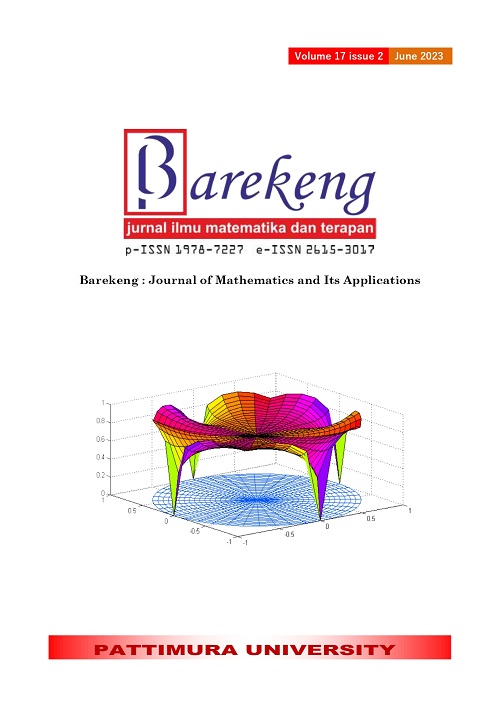MODEL ANALYSIS OF THE SPREAD OF COVID-19 WITH LOGISTIC GROWTH RECRUITMENT
Abstract
This paper to analyzes the COVID-19 model with the growth of the logistics recruitment rate. Based on the model determined, the non-endemic stability points, threshold, and endemic stability points are obtained. The nonendemic stability point is asymptotically stable if the spread of COVID-19 decreases and vice versa. If the spread of COVID-19 increases, then the endemic stability P1 is globally asymptotically stable. Based on numerical simulations, the greater the recruitment rate, then the greater the number of susceptible and vaccinated subpopulation individuals. The smaller the value of the contact rate between infected individuals and those who are still healthy, the lower the number of infected individuals and vice versa, while the number of recovered subpopulation individuals is increasing. The greater the rate of treatment, the lower the number of infected individuals.
Downloads
References
R. ud Din, A. R. Seadawy, K. Shah, A. Ullah, and D. Baleanu, “Study of global dynamics of COVID-19 via a new mathematical model,” Results Phys., vol. 19, p. 103468, 2020.
S. S. Musa, S. Qureshi, S. Zhao, A. Yusuf, U. T. Mustapha, and D. He, “Mathematical modeling of COVID-19 epidemic with effect of awareness programs,” Infect. Dis. Model., vol. 6, no. February, pp. 448–460, 2021.
L. Basnarkov, “SEAIR Epidemic spreading model of COVID-19,” Chaos, Solitons and Fractals, vol. 142, p. 110394, 2021.
J. Tian et al., “Modeling analysis of COVID-19 based on morbidity data in Anhui, China,” Math. Biosci. Eng., vol. 17, no. 4, pp. 2842–2852, 2020.
A. Godio, F. Pace, and A. Vergnano, “Godio-2020-SEIR Modeling of the Italian Epide1.pdf,” 2020.
J. Nainggolan and M. F. Ansori, “Stability and Sensitivity Analysis of the COVID-19 Spread with Comorbid Diseases,” Symmetry (Basel)., vol. 14, no. 11, p. 2269, 2022.
Y. Fang, Y. Nie, and M. Penny, “Transmission dynamics of the COVID-19 outbreak and effectiveness of government interventions: A data-driven analysis,” J. Med. Virol., vol. 92, no. 6, pp. 645–659, 2020.
J. Ma, “Estimating epidemic exponential growth rate and basic reproduction number,” Infect. Dis. Model., vol. 5, pp. 129–141, 2020.
M. De La Sen and A. Ibeas, “On a Sir Epidemic Model for the COVID-19 Pandemic and the Logistic Equation,” Discret. Dyn. Nat. Soc., vol. 2020, 2020.
P. Wang, X. Zheng, J. Li, and B. Zhu, “Prediction of epidemic trends in COVID-19 with logistic model and machine learning technics,” Chaos, Solitons and Fractals, vol. 139, 2020.
E. Aviv-Sharon and A. Aharoni, “Generalized logistic growth modeling of the COVID-19 pandemic in Asia,” Infect. Dis. Model., vol. 5, pp. 502–509, 2020.
K. Wu, D. Darcet, Q. Wang, and D. Sornette, “Generalized logistic growth modeling of the COVID-19 outbreak: comparing the dynamics in the 29 provinces in China and in the rest of the world,” Nonlinear Dyn., vol. 101, no. 3, pp. 1561–1581, 2020.
C. Y. Shen, “Logistic growth modelling of COVID-19 proliferation in China and its international implications,” Int. J. Infect. Dis., vol. 96, pp. 582–589, 2020.
T. Tene, M. Guevara, J. Svozilík, R. Tene-Fernandez, and C. V. Gomez, “Analysis of covid-19 outbreak in ecuador using the logistic model,” Emerg. Sci. J., vol. 5, no. Special issue, pp. 105–118, 2021.
P. Saha and U. Ghosh, “Global dynamics and control strategies of an epidemic model having logistic growth, non-monotone incidence with the impact of limited hospital beds,” Nonlinear Dyn., vol. 105, no. 1, pp. 971–996, 2021.
F. Inayaturohmat, N. Anggriani, and A. K. Supriatna, “A mathematical model of tuberculosis and COVID-19 coinfection with the effect of isolation and treatment,” Front. Appl. Math. Stat., vol. 8, 2022.
J. Nainggolan and Fatmawati, “Optimal prevention strategy of the type sir covid-19 spread model in Indonesia,” Commun. Math. Biol. Neurosci., vol. 2021, pp. 1–13, 2021.
S. İğret Araz, “Analysis of a Covid-19 model: Optimal control, stability and simulations,” Alexandria Eng. J., vol. 60, no. 1, pp. 647–658, 2021.
P. Van Den Driessche and J. Watmough, “Reproduction numbers and sub-threshold endemic equilibria for compartmental models of disease transmission,” Math. Biosci., vol. 180, no. 1–2, pp. 29–48, 2002.
J. P. LaSalle, “Stability theory for ordinary differential equations,” J. Differ. Equ., vol. 4, no. 1, pp. 57–65, 1968.
Copyright (c) 2023 Jonner - Nainggolan

This work is licensed under a Creative Commons Attribution-ShareAlike 4.0 International License.
Authors who publish with this Journal agree to the following terms:
- Author retain copyright and grant the journal right of first publication with the work simultaneously licensed under a creative commons attribution license that allow others to share the work within an acknowledgement of the work’s authorship and initial publication of this journal.
- Authors are able to enter into separate, additional contractual arrangement for the non-exclusive distribution of the journal’s published version of the work (e.g. acknowledgement of its initial publication in this journal).
- Authors are permitted and encouraged to post their work online (e.g. in institutional repositories or on their websites) prior to and during the submission process, as it can lead to productive exchanges, as well as earlier and greater citation of published works.






1.gif)



